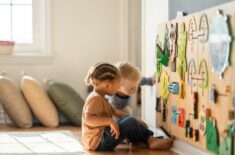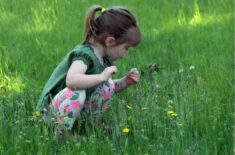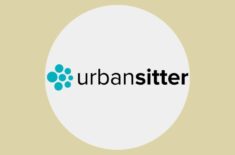Overview
Preschool helps foster your child’s brain development, with researchers and educators calling this stage the foundation for learning. (1)(2)
Studies show that the skills preschoolers learn in early childhood education can have life-long consequences and affect adult outcomes: (3)(4)(5)
- Better school completion rates in higher education
- Higher lifetime earning rates
- Lower crime rates
Kids who attend preschool might also have better health outcomes because they may be more likely to do the following: (6)
- Improve cognitive, social, and emotional development as kids
- Receive immunizations or go to a doctor for checkups and screenings
- Get dental care
That’s why high-quality preschool education is important. Because the “simple” things they learn in their early years can affect how they turn out as adults. (7)
Studies also show that kids in smaller classes (better learner-to-staff ratio) may be more likely to go to college and have high-earning professions, such as business, economics, and STEM (science, technology, engineering, and mathematics). (8)
The number of years spent in preschool may also affect adult outcomes.
Children who attended two years of preschool education may be less likely to commit crimes, be abused or neglected, or receive special education than those who only went to preschool for one year. (4)
What are preschool programs, and at what age can your kids attend? Is preschool learning free? What can you expect your preschool child to learn from these providers? Find out below.
What Age Group Are Preschoolers?
The terminology and definitions vary among different countries. Still, preschool kids are usually considered to be a child from two to five years of age studying in a nursery or early education school.
Many nursery schools, particularly in the US, also offer daycare or child care services to kids from 0 months to 2.5 years old. Some also offer special education classes to children with disabilities.
What’s The Purpose Of Preschool?
Preschool education gives your child a head start in school through social interactions and learning through play. Your child can begin learning about the ABCs, numbers, colors, shapes, etc.
In the US, Pre-K (pre-kindergarten) is offered as an initiative to provide children from four to five years old with improved access to pre-primary schools.
Preschool programs are often open only during school days and follow the state’s school year schedule. Many are available for only part of the day (separate morning and afternoon classes), but some also have full-day classes.
The next level, kindergarten, marks the start of formal education in the US. It’s for children five to six years old. This level is offered in nursery schools, but many elementary schools also offer kindergarten.
Why Is Preschool Important?
Human development is complex and influenced by internal (such as genetics) and external (such as environmental conditions) factors.
The foundations of cognitive learning, social and emotional development, self-regulatory capacities, and behavior are laid out during the first five years of your kid’s life. (5)
Learning & Positive Parenting
Your child’s development and growth start at home. Parents have an important role as their first teacher, role model, and main cheerleader.
Why Families Choose Preschool
Different families have varied reasons for choosing a preschool, but here are some common ones:
- They don’t need the services of a full-day, full-year care center
- They want a program that focuses on school readiness
- They need special education services for a child with a disability
How To Choose A School
- Meets the quality standards set by the state
- Provides a nurturing, stimulating environment for preschoolers
- Licensed teachers with early childhood credentials and professional development
- Curriculum (especially if you prefer Montessori or Waldorf)
- Safe environment for learning
- Supports developmentally appropriate activities for young children
- Class size (student-to-staff ratio)
- Options for after-school activities (if you want)
- Online registration options
Always check their disclaimer to ensure that they will take responsibility for your child throughout their stay in the facility.
Montessori & Waldorf Learning
Montessori
Different stations for hands-on, interactive learning are available inside the classroom. Your child can choose any station and explore it independently or with the help of their teacher. (9)
They also learn practical skills like cooking using Montessori-based, age-appropriate toys and equipment. (9)
Waldorf
The emphasis is on creativity, singing songs, playing musical instruments, and creating art using high-quality materials. It’s based on the philosophy that kids need to develop their creative minds at this age. (9)
What Are Some Preschool Activities?
Preschoolers learn the basics of counting, reading, and various cognitive or emotional skills through art and unstructured activities.
They’re encouraged to use their imaginations to play, yet they’re also learning while doing all these things. (10)
Some examples of activities your preschool child can do at home or in their nursery school: (10)
- Playdough and clay – help develop their fine motor skills
- Matching games and simple jigsaw puzzles – help improve their memory and concentration
- Balls – throwing, kicking, rolling, or catching balls can help improve their gross motor skills and balance
- Empty boxes, sticks from your yard, old milk containers, unused kitchen items (check for sharp parts), wooden spoons, etc. – promote imaginative play or making up music
- Blocks and building materials – promote reasoning, logic, and motor skills
- Art materials – promote creativity
Preschool Growth & Development
Developmental Milestones: 2-3 Years Old
Kids develop at different rates, but here are some of the most common developmental milestones for this age group: (11)
Physical Skills
- Stand on tiptoes
- Tries to balance on one foot
- Walks and runs
- Climbs on furniture (that’s why it’s important to childproof your home)
- playground equipment
- Walk up the stairs (holds the railing); may alternate feet
- Starts learning how to jump with both feet
- Pulls or carries toys while walking (sometimes doing this with several toys at once)
- Throws and kicks a ball
- Tries to catch a ball with both hands
Social Skills
- Mimics adults and other kids
- Enjoys playing with friends
- Might only want to play near but not with unfamiliar kids
Cognitive Thinking
- Enjoys pretend play
- Talks about things in the past and uses phrases like “a long time ago” or “yesterday”
- Can solve a three- to four-piece puzzle
- Groups toys according to type, color, or size
- Sings or recites nursery rhymes
- Recites favorite books
- Can follow two-step directions
- Starts asking “why” and “what’s that?”
Communication Skills
- Continues to build their vocabulary
- Combines simple words to create a simple but understandable phrase
- Repeats words they like to hear
- Learns how to use singular and plural words
Fine Motor & Other Skills
- Might hold crayons or utensils using their fist but slowly learn to grasp with their fingers
- Builds a tower with at least four blocks
- Starts brushing their own teeth and hair
- Learns to pull their pants up and down
- Learns to operate the faucet to wash hands
- Starts practicing with snaps and zippers
Developmental Milestones: 3-4 Years Old
These are the typical developmental milestones in this age group: (12)(13)
Physical Skills
- Plays with balls
- Can walk in straight, zigzag, etc. lines
- Climbs
- Learns to pedal a bike
- Climbs stairs by alternating feet
Social Skills
- Doesn’t want to share toys or food
- Mood swings and might not want to play with other children
- Might prefer playing with their imaginary friends
Cognitive Thinking
- Understands concepts like twist-on bottle tops or working door handles
- Knows some ABCs, numbers 1-10, and basic colors and shapes
- Follows three-step directions
- Can retell their favorite story in their own words
Communication Skills
- Might say they’ll run away (especially when they think they’re in trouble or did something wrong)
- Understands basic grammar rules but can make mistakes on words that don’t follow the rules (such as the plural of “house” is “houses,” so they might say “mouses” instead of “mice”)
Fine Motor & Other Skills
- Learns to hold crayons and utensils properly
- Plays with toys with movable parts
- Plays with “real-life” toys, like toy kitchens or toy lawn mowers
Developmental Milestones: 4-5 Years Old
Skills and developmental milestones can vary, but most kids this age have the following: (12)(14)
Physical Skills
- Catch and throw a ball
- Balance on one foot
- Skip and hop on one foot
- Walk backward
- Walk downstairs alone
- Jumps over objects
Social Skills
- Communicates with other kids
- Shares toys and plays with other kids
Cognitive Thinking
- Understands the difference between fantasy and reality
- Can draw a person with separate body parts (head, arms, legs, and human shape)
- Build a tower with 10 blocks or more
- Draws basic shapes (circle and square)
- Pretend play
- Understands commands with multiple steps or instructions
- Begins to understand concepts (such as time) and abstract ideas
- Might compare your rules with the ones their friends follow
Communication Skills
- Can express themselves
- Asks questions constantly, including about how things work or real facts about the world
- Likes telling stories
- Repeats words or phrases they frequently hear
Fine Motor & Other Skills
- Can dress themselves
- Can handle buttons and zippers on their own
- Use scissors without assistance
- Shows interest in helping around the house
- Begins to lose their baby teeth
- Draws wavy or zigzag lines
Costs Of Preschool Education
Private Schools
Costs can vary depending on your school district and location.
For example, California’s average private preschool tuition can be around $11,457 per year (2022). Elementary and middle school tuition rates are typically higher (around $14,835 per year). (15)(16)
The average is just around $6,492 per year in Ohio. (17)
It’s around $15,334 per year in New York, while it’s just around $5,019 in Mississippi. (18)(19)
Public Schools
Free Pre-K program access is limited in most cities in the US. Although some offer free or subsidized preschool education, most don’t have this program. (6)
The National Institute for Early Education Research (NIEER) also discovered that only 60% of the largest US cities have a preschool enrollment of over 30% of their 4-year-old population. (6)
These cities may offer better access to preschool education and Pre-K programs than others: (6)
- Washington, D.C. – nearly the entire population of their 3- and 4-year-olds
- New York City – nearly all 4-year-olds and may be ready to serve all 3-year-olds
- Jacksonville (Florida), Atlanta (Georgia), and Tulsa (Oklahoma) – most 4-year-olds through accessible state-funded Pre-K services
Head Start
This US Department of Health & Human Services program helps young children from low-income families prepare for school success through health, early learning, and family well-being. (20)
Non-profit Organizations
Some non-profit organizations offer free education for preschoolers and school-age children (6-12 years old).
Others don’t have their own schools but offer to subsidize part of your child’s tuition fees.
REFERENCES
(1) https://www.ncbi.nlm.nih.gov/pmc/articles/PMC3722610/
(2) https://www.gov.ca.gov/2021/07/09/california-roars-back-governor-newsom-signs-historic-education-package-to-reimagine-public-schools/
(3) https://pubmed.ncbi.nlm.nih.gov/24634518/
(4) https://www.ncbi.nlm.nih.gov/pmc/articles/PMC4727175/
(5) https://books.google.com/books?hl=en&lr=&id=20uMru2UbTgC&oi=fnd&pg=PR3&ots=WpNhuMaFGj&sig=sQG2X4Aunwr3-n-coPyikdXn51Y#v=onepage&q&f=false
(6) https://static1.squarespace.com/static/5ad9018bf93fd4ad7295ba8f/t/5c4783938a922d0603df4d09/1548190627628/Pre-K+in+American+Cities.pdf
(7) https://www.ncbi.nlm.nih.gov/pmc/articles/PMC3445416/
(8) https://onlinelibrary.wiley.com/doi/abs/10.1002/pam.21715
(9) https://www.familyeducation.com/waldorf-or-montessori-which-education-will-work-your-family
(10) https://raisingchildren.net.au/newborns/play-learning/play-ideas/why-play-is-important
(11) https://www.understood.org/articles/en/developmental-milestones-for-typical-2-year-olds?_sp=cc14166c-a0b2-4e36-a09b-769fbeb19f8d.1648518052600
(12) https://www.choc.org/primary-care/ages-stages/4-to-5-years/
(13) https://www.understood.org/articles/en/developmental-milestones-for-typical-3-year-olds?_sp=cc14166c-a0b2-4e36-a09b-769fbeb19f8d.1648518047186
(14) https://www.understood.org/articles/en/developmental-milestones-for-typical-4-year-olds?_sp=cc14166c-a0b2-4e36-a09b-769fbeb19f8d.1648519614355
(15) https://www.privateschoolreview.com/tuition-stats/california/pre
(16) https://www.privateschoolreview.com/tuition-stats/california/elementary
(17) https://www.privateschoolreview.com/tuition-stats/ohio/pre
(18) https://www.privateschoolreview.com/tuition-stats/new-york/pre
(19) https://www.privateschoolreview.com/tuition-stats/mississippi/pre
(20) https://eclkc.ohs.acf.hhs.gov/












